Campus arrests last spring fractured long-standing protections Yale has historically extended to student protestors.
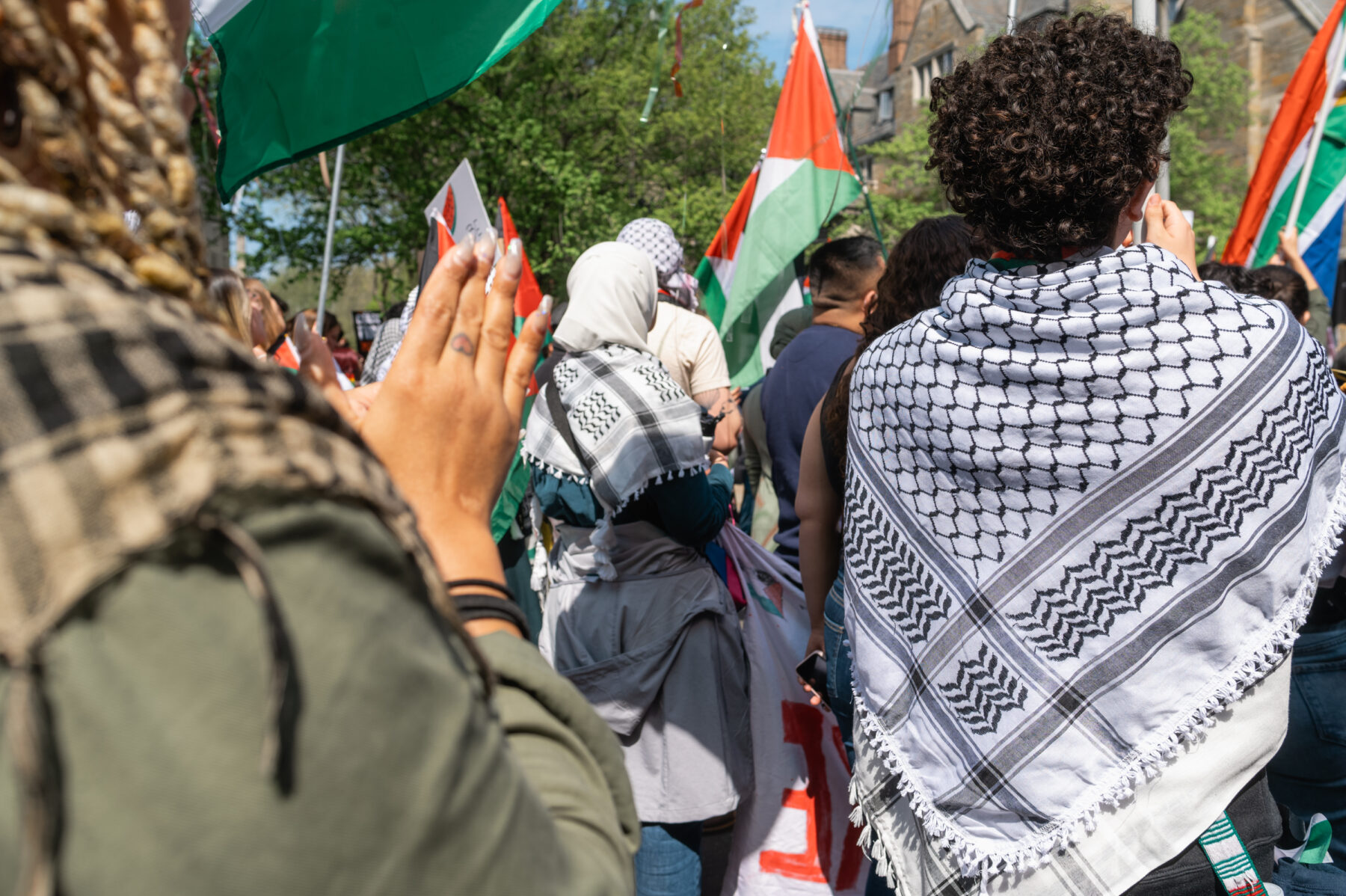
I. Disperse and Arrest
Hutten didn’t resist when police officers zip-tied her wrists, shouldering her and forty-seven other arrestees, at least forty-four of whom were students, through the Schwarzman Center.
Tacey Hutten ’26 was asleep inside a tent on Beinecke Plaza at 6 a.m. on April 22, when her friend shook her awake to inform her that police officers were outside the encampment. Hutten and other protesters had anticipated that they would be arrested, but not that the police would show up this early in the morning. For three days, Hutten, among hundreds of other students, had been occupying the plaza, protesting the university’s investments in weapons manufacturing amid Israel’s ongoing bombardment of Gaza, which has killed over forty thousand people. They had contended with threats of arrest from the Yale Police Department for three nights, refusing administrators’ orders to disperse their encampment of over two dozen tents, where they had hosted teach-ins, artwork displays, student group performances, and mutual aid support. On the previous day, the university offered the protesters a final deal: in exchange for dispersing, organizers would be granted a meeting with two trustees of the Yale Corporation, which makes final determinations regarding university investments. The protesters turned it down.
Hundreds of students gathered around the encampment the night of April 21, linking arms to form a protective ring. A hundred voices chorused into one. Just like a tree that’s planted by the water, they sang, we shall not be moved.
Police waited until dawn the next day to announce their final dispersal warning.
As the YPD officers closed in, over fifty demonstrators awoke and assumed the same protective stance, again linking arms as they circled the Beinecke flagpole. As the demonstrators sang the protest spiritual “We Shall not be Moved,” officers arrested students in rounds, picking out a few protesters at a time as others waited to be taken. Protester Kai Padilla-Smith ’25 described how students were made to wait shivering for over an hour as the tents were ripped down behind them.
“It was very clearly part of the university’s continued psychological pressure on student activists. Why are you showing up at six in the morning when we were all up until three rallying to keep you away?” Hutten said. “That is where this university’s resources go into—the policing and criminalization of its own students—as well as the funding of bombs and missiles and tanks that are just decimating Gaza.”
Hutten didn’t resist when police officers zip-tied her wrists, shouldering her and forty-seven other arrestees, at least forty-four of whom were students, through the Schwarzman Center. Spectators and supporters heckled the officers and cheered for the protesters as they were loaded into Yale buses. The buses shook from the arrestees stomping, singing, and cheering pro-Palestine slogans inside. All of the arrestees were charged with criminal misdemeanors for trespassing.
When justifying the arrests, the university pointed to protesters’ refusal to disperse and claimed that the demonstrations blocked paths to the Schwarzman Center.
“Prior to their removal from the plaza, the university spent several hours in discussions with student protestors, offering them opportunities to meet with trustees, and to avoid arrest if they left the plaza by the end of that weekend,” a university spokesperson wrote to me.
Following the arrests, the Sumud Coalition—formerly known as Occupy Beinecke, the coalition of student groups that organized the protests—has campaigned for Yale to drop the charges via social media and online petitions that have garnered thousands of signatures. While Yale cannot directly revoke the charges pressed by the state of Connecticut, it does have the power to ask the state to do so—a move that could weigh heavily in the state’s decision.
University president Maurie McInnis has asserted that Yale has no agency in the legal system. Weeks before the hearing, she told the Yale Daily News that the hearing outcome “really isn’t in our hands.”
“I know people imagine it might be, but it’s not,” McInnis said. “Yale is not getting involved.”
The argument that Yale cannot get involved by pressuring prosecutors in the cases against its students is perplexing, given that the University ordered the protestors arrested in the first place. Beinecke Plaza is the university’s private property, so only Yale can make final calls about what legally constitutes trespassing. Yale administrators—not the Yale or New Haven police departments, the city of New Haven, nor the state of Connecticut—called on police to descend upon the students that morning.
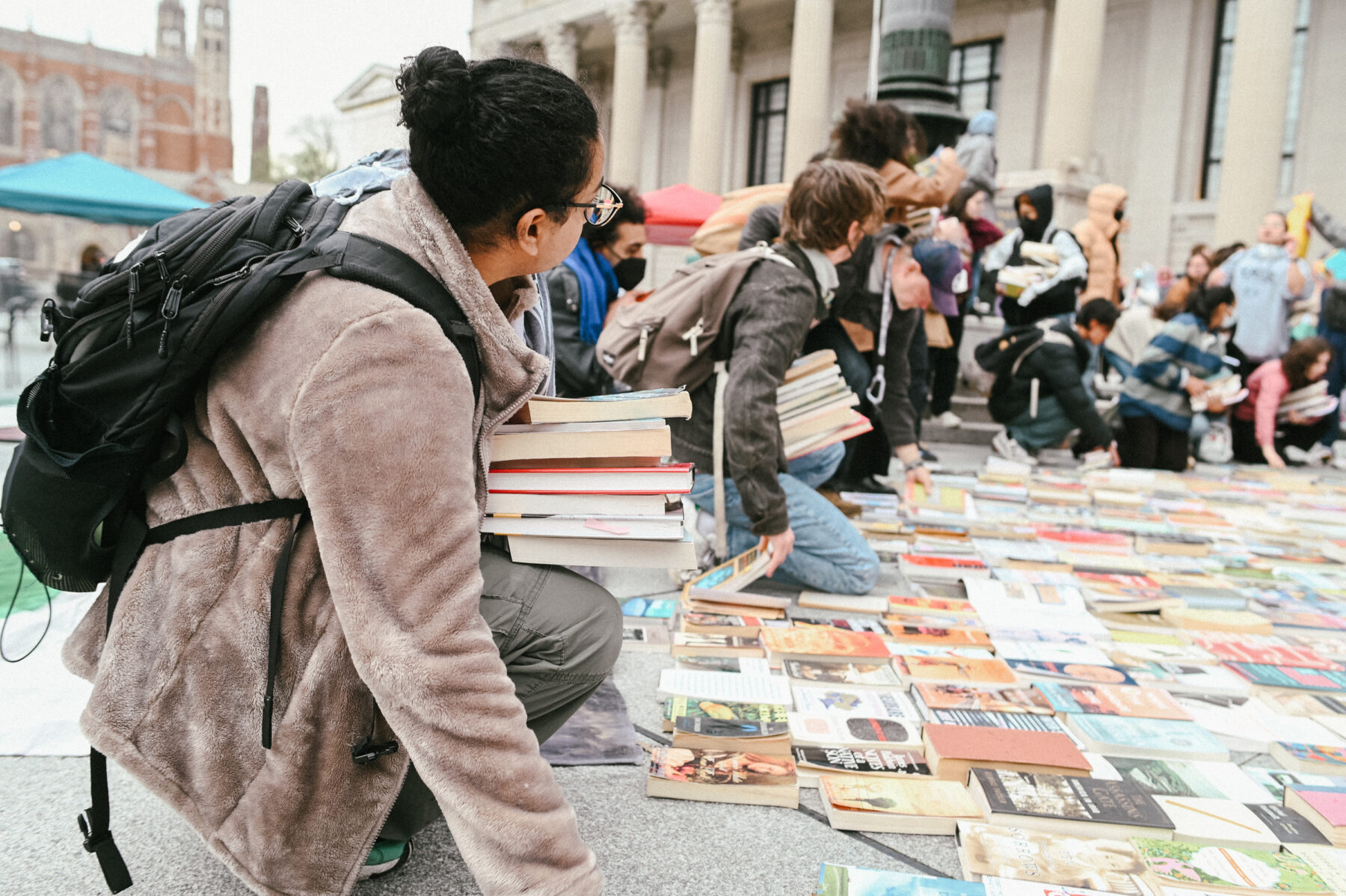
Six months after the mass arrest, on the morning of Halloween, Hutten and forty other keffiyeh-clad students clustered inside the lobby of the New Haven Superior Court for their hearing. It was either the third or fourth hearing for most of the students, depending on whether they appeared at a virtual hearing in June. Demonstrators said that they and their lawyers pushed for continuances from previous hearings to pressure Yale into asking the state to drop the charges, a move symbolizing their arguments that the university should not have involved police and that the students should not have been charged in the first place. Yale never budged.
“The arrests were an arbitrary and abusive exercise of power that Yale knows that it has,” Hutten said. “And dropping the charges is one of the first bare minimum things that you can do in order to start to remedy that situation.”
At the Halloween hearing, about two-thirds of the protesters agreed to a deal in which their misdemeanor criminal trespassing charges would be lowered to a lesser charge of trespass infraction for a ninety-dollar fee.
Hutten and Padilla-Smith were among the two-thirds of protesters to agree to the deal, wearied by months of litigation, anxious about their upcoming appearances in front of the university’s executive committee, and eager to focus on campus activism in support of the people of Gaza. The remaining thirteen students declined to take the deal, continuing the fight to get their charges dropped at yet another hearing in December.
I spoke to twelve alumni involved in five different civil disobedience movements at Yale over four decades. All of them expressed a belief that the administration cracked down unusually hard on the pro-divestment protesters last spring—a break from the protections the university has historically provided student protesters. It is unprecedented that students arrested en masse spend over six months in legal limbo, even more so that thirteen are still fighting charges. And over a week after the arrests on Beinecke, YPD violently arrested protesters without direct orders from administration—setting a precedent that could compromise the safety of student protesters and free expression on campus.
“It did feel strange walking around campus, feeling like I have been criminalized by my own institution,” Padilla-Smith said. “Yale likes to tout its student body as this politically active group of people that wants to make a difference in the world, but then when you try to actually align yourself with those values, they punish you.”
II. Police Power
Student activists have carried a unique status throughout history precisely because they are students. Those attending elite institutions like Yale benefit from their association with powerful institutions that have long protected them from harsh recourse in the criminal justice system, allowing them to wield their privilege as a tool for change.
“It’s important, the level of privilege these students collectively—not individually—are able to summon in terms of attention from the media and historically better treatment by police,” said Beth Coleman ’91, a former anti-apartheid protester who is now a professor at the University of Toronto. In the hours after the pro-Palestine Yale students were arrested, the story made headlines in The New York Times, USA Today, the Washington Post, CNN, and dozens of other news outlets.
“These are the people who are credible and can risk getting bad grades, but they don’t have to risk losing their jobs,” Coleman continued. “They’re able to stand up in a principled way for things that need to change in the world.”
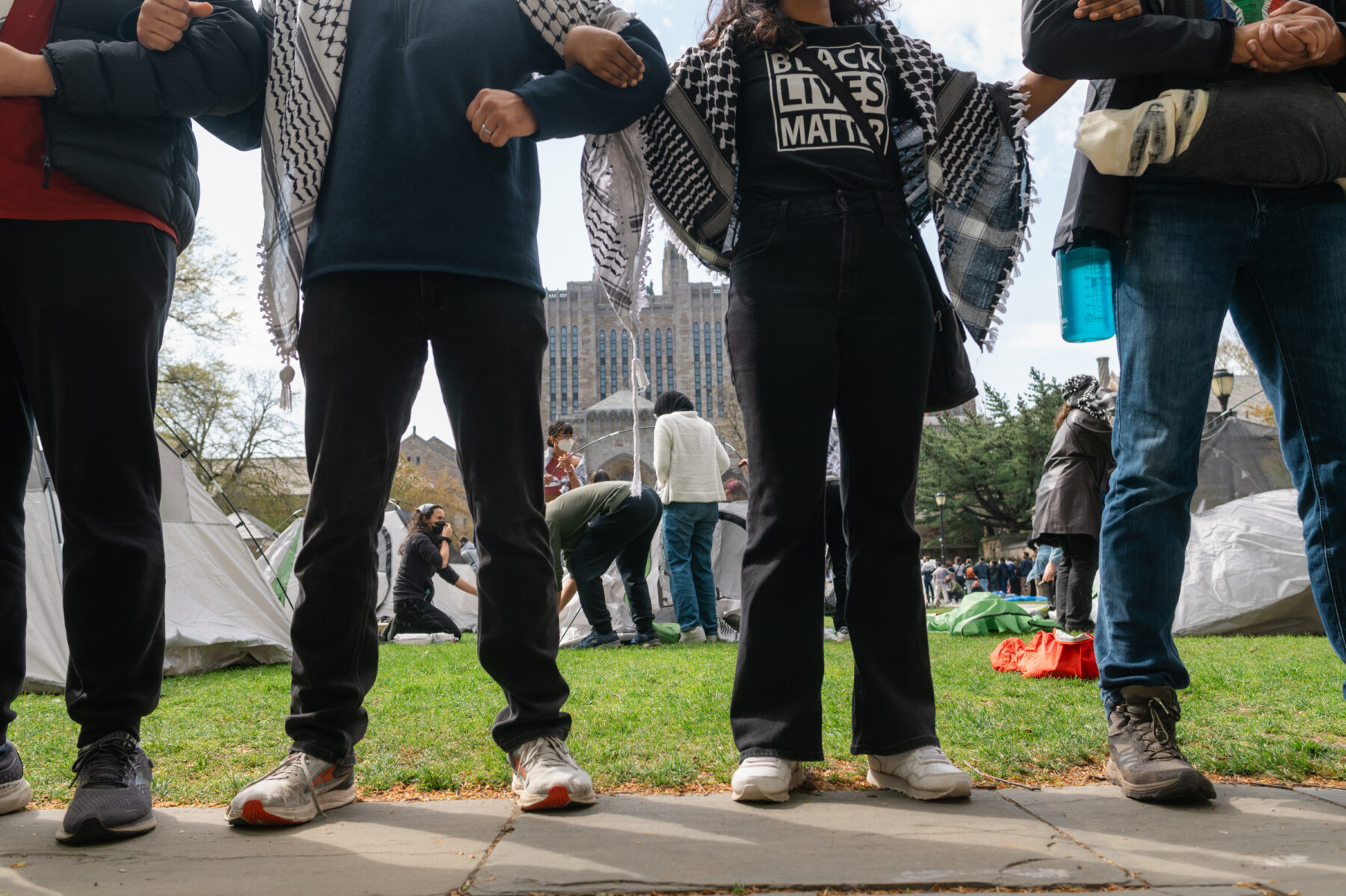
What distinguishes civil disobedience from other forms of peaceful protest is the act of breaking rules and welcoming consequences—legal, academic, or professional—to emphasize the gravity of a cause on a public stage. Even so, supporters of Yale’s arrestees have stressed that the University has a duty to protect its students from the potential violence of policing and to uphold their freedom of expression—even when administrators, trustees, and Yale Corporation members disagree with their actions and words.
Professor of Women’s, Gender, and Sexuality Studies Greta LaFleur, who serves as an attorney for dozens of the students arrested last spring, said she believes that the university’s choice to involve the police to quell the protests later empowered officers to crack down on students, even without direct orders from Yale administrators.
“I don’t think there’s any coincidence whatsoever that the arrests were broadly non-violent on the part of police behavior on April 22, but the arrests on May 1 were brutal,” LaFleur said. “That’s what happens when you bring cops on campus to do the enforcement of disciplinary procedures or of behavioral policies.”
After April’s mass arrests on Beinecke Plaza, police confrontations with protesters had momentarily calmed, despite continuing demonstrations and the construction of a second encampment on Cross Campus, which police dismantled and dispersed after three days without further arrests.
On May 1, however, a group of demonstrators marched around campus, delivering speeches and chanting outside of then-president Peter Salovey’s home and the YPD station. After a YPD lieutenant warned protesters to disperse from the station over the speaker of his police car, protest marshal Craig Birckhead-Morton ’24 and the other marshals directed the protesters to leave, ushering them back to central campus.
“Obviously, we took this warning seriously,” Birckhead-Morton said. “The police were caught off-guard. I think they really thought that they had really defeated us, so they were surprised.”
But as the group approached the walkway between Yale Law School and Sterling Memorial Library, Birckhead-Morton, who was arrested as part of the encampment a week prior, was confused to see YPD cars waiting by Beinecke Plaza. A police car suddenly drove directly into the crossway to block their path.
Unlike the April 22 arrestees, no one had joined this demonstration thinking they were risking arrest. Unlike those who had been arrested en masse, they hadn’t received training on handling police interactions during nonviolent protests. It was Birckhead-Morton’s job as a marshal to ensure protesters’ safety. But when Birckhead-Morton approached Lieutenant Chris Halstead—the same officer who ordered demonstrators to leave the YPD station—to ask how the protesters were supposed to disperse, Halstead grabbed him by the arm, pulling him towards the police car. It was Birckhead-Morton’s twenty-second birthday, and he had been holding his birthday cake.
“I think it pissed them off that we had been able to sustain ourselves after everything that had happened,” Birckhead-Morton said. “The crowd [was] outraged, because why are you arresting people who are keeping the students safe?”
Protesters crowded around the car as another student marshal repeatedly asked Halstead why Birckhead-Morton was being arrested. An officer placed her under arrest. One person grabbed Birckhead-Morton’s other arm to tug him away from Halstead, who was eventually able to handcuff him. From the window of the police car, Birckhead-Morton watched as another officer held a protester from the New Haven community against a squad car. A second officer broke through protesters and tackled another New Havener. Chief of Police Anthony Campbell ’95 DIV ’09, aided by three other officers, kneeled on the protester’s back for over ninety seconds. The protester emerged with a bleeding nose and cut face.
“It seemed like the cops were kind of on a bit of a power trip,” said Rebecca Wessel ’24, a student organizer who was present for the May 1 arrests. “And maybe wanting to assert power after they had seen how many people were rallying against them at the YPD office.”
Duane Lovello, Head of Public Safety, released a statement on the May 1 arrests on August 26. An external review of the incident, it disclosed, found that probable cause supported each arrest, but “the arrests taken in total did not follow best practices,” including on crowd control and the disproportionate force used in one of the arrests.
In an email exchange dated May 4 obtained by student journalist Theia Chatelle ’25, YPD assistant chief of police Von Narcisse wrote to Campbell that the pro-Palestine demonstrators “are pathetic and sad,” going on to criticize the protests as a “sad attempt to attack Yale” that is unrelated to the events in Israel and Gaza.
“I agree 100 percent. There [sic] actions are like a small group of vandals and criminals rather than protesters,” Campbell replied.
In response to a request for comment, Campbell did not answer inquiries regarding the email exchange or the events of April 22 and May 1. He confirmed that the YPD advisory committee, a civilian review board created to ensure police accountability, is no longer active and said that the university is “considering refinements to its scope of advisory responsibilities.” When Birckhead-Morton was a student, he was part of the committee.
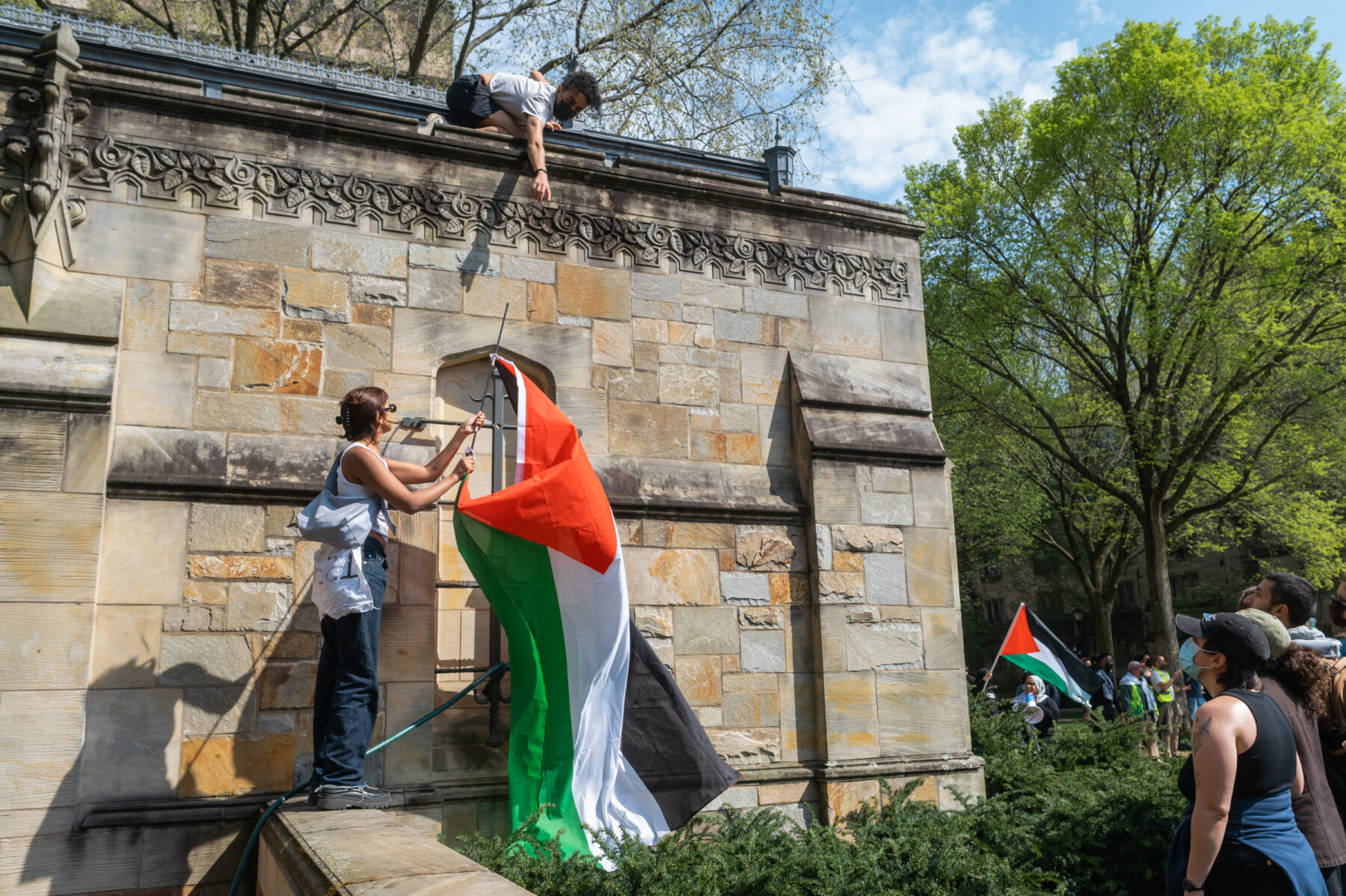
III. Whose Beinecke?
The Occupy Beinecke encampment drew in part from one of the most famous instances of student civil disobedience in Yale history: the anti-apartheid protests of the 1980s, in which students fought for Yale to divest from companies with holdings in South Africa. On Instagram, posts that included side-by-side photos from the pro-Palestine demonstrations and the anti-apartheid protests garnered thousands of likes. Yet alumni told me that the details of the arrests and administrative responses at the two protests differed, revealing an increasing hostility toward student protesters last spring.
For ten days in April 1986, Matthew Countryman ’86 and about twenty other Yale students slept atop soggy newspapers, packed together inside rickety wood and aluminum forts on Beinecke Plaza.
After a year of rising dissent on campus, the anti-apartheid protesters set up a cluster of structures, aiming to resemble the poor and crowded urban shanties where Black South Africans were forced to live by the country’s white minority. Like the pro-Palestine protesters who erected the Beinecke encampment, the Coalition Against Apartheid activists never asked the university for permission to pitch up the shanties.
“University investment was the rationale for our violation of the university policy. In other words, the university was pursuing immoral policies in South Africa, and that gave us the right,” Countryman told me this September.
The organizers of Beinecke Plaza’s newly erected “Winnie Mandela City” deliberately chose April 4th, 1986, for the shanties’ debut. It was the 18-year anniversary of Martin Luther King Jr.’s assassination. It was also the weekend that the Yale Corporation would meet in person. Each day that week, hundreds gathered for rallies protesting Yale’s investments in companies doing business in South Africa.
The Winnie Mandela City first came down ten days after it went up. The Yale Police Department had given a final warning for student protesters to vacate the plaza by midnight. Similar to the events of April 22, 2024, arrests happened early the next morning. About three dozen Yale Police officers descended on the plaza at dawn to arrest seventy-two students and four New Haven community members. Countryman chose to go limp as officers dragged him away, pleading with them to not take him from his home.
Police loaded students into buses and took them to the city jail, where they were then booked and quickly released.
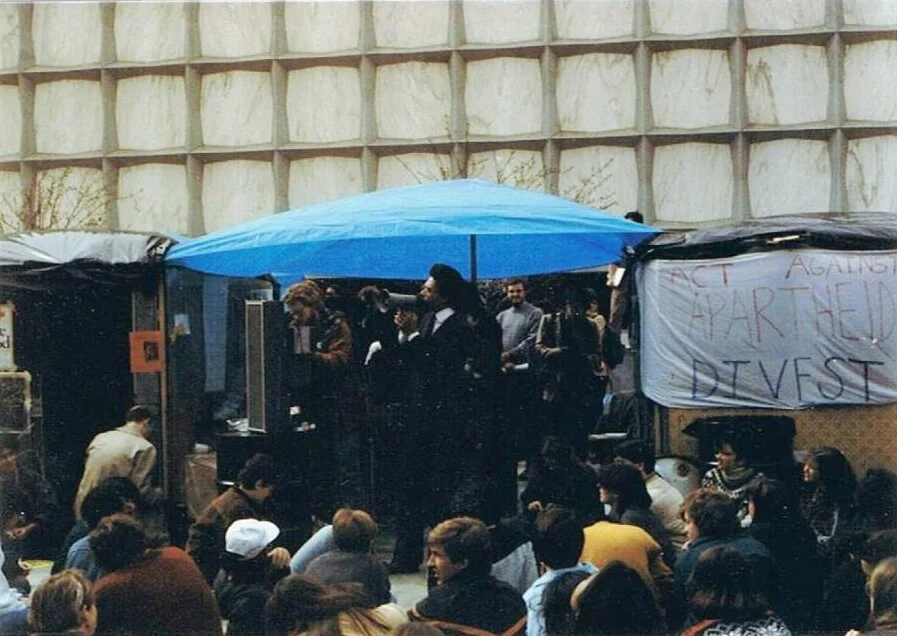
The shanties of the anti-apartheid protest on Beinecke, late 1980s. Photo courtesy of Elizabeth Juliver ’90 for the Yale Alumni Magazine.
The first round of arrests in April 1986 drew massive backlash from public figures in local and state politics. Within the Yale community, distaste was even stronger.
Democrats from the Connecticut House of Representatives even proposed a bill to revoke Yale’s charter in the state constitution over the arrests; House minority leader Irving Stolberg declared that “Yale has clamped down in an arbitrary and arrogant manner… rather than encouraging dialogue.”
One hundred and fifty-six faculty members signed a statement expressing disapproval of Yale’s arrests of its students. It asserted that the university was guilty of “breaking an important tradition of trust among all members of the University community with regard to the free expression of divergent viewpoints.”
The outrage produced quick results. A faculty committee, convened by administrators, announced that the university had to allow student activists to reconstruct the Winnie Mandela City and let it remain until the start of June. The permission was contingent on the shanties not preventing others’ use of the plaza as a thoroughfare or a space for other gatherings.
In the following three days, two more rounds of arrests occurred at other apartheid-related, pro-divestment demonstrations.
Protesters were charged with misdemeanors, but about a week after the arrests, prosecutors exchanged those charges for infractions on their own accord. This time, prosecutors offered arrestees a deal: plead not-guilty or donate twenty-five dollars to a charity organization and drop the infractions immediately. Otherwise, the state would automatically enter a no-contest plea in which infractions would be dropped in no sooner than thirteen months given no further legal troubles.
“With one stroke of a pen, [prosecutors] got rid of all those cases,” former anti-apartheid protester Doug Carver ’88 said. In contrast, he pointed to the unusually protracted legal process for the pro-divestment protesters arrested last spring. “Seven months, that takes you from one school year to the next, one academic year to the next. There was definitely nothing like that.”
Pro-Palestine protesters not only contended with a longer legal process than anti-apartheid protesters, but also tighter restrictions from administrators. While former university president Bart Giamatti told students they could build shanties elsewhere on campus, negotiations over the potential reinstatement of last spring’s encampments have never occurred. Instead, Yale adopted guidelines that outright banned unregistered student groups like the Sumud Coalition from hosting outdoor gatherings, though daytime demonstrations and teach-ins have continued this semester. The anti-apartheid shanties stayed for another two years with sanction after their inception, only coming down in the summer of 1988 when a disgruntled alum set them ablaze.
Coleman, who had protested apartheid, said she felt that despite administrators’ “shockingly brittle” initial response of multiple rounds of arrest, they respected the practice and history of nonviolent protest. Countryman agreed that he did not feel personal hostility toward students from University Secretary John Wilkinson ’60, the administrator in charge of addressing student protests.
“I thought we had a very positive relationship, and it didn’t change when we did get arrested. In that sense, [Wilkinson] didn’t get angry with us. His commitment to maintaining dialogue and negotiation very much remained in place,” Countryman said. Their relationship later grew into a friendship with Wilkinson that persists in the present; the former administrator attended Countryman’s wedding years after his graduation.
Meanwhile, current Yale protesters have felt that administrators openly express animosity toward them. Hutten pointed to a faculty-wide email that Yale College Dean of Students Pericles Lewis sent shortly after the arrests, in which he characterized protests as increasingly dangerous due to “non-Yale protesters with a known history of violent confrontation with the police.” He urged faculty to ask that students stop associating with them. In a statement to the Yale Daily News, Lewis later apologized for insinuating that the protests would become violent without evidence and said he erred in repeating mere speculation.
“It has been made very clear to us that this campus isn’t for us,” Hutten said, “and that we are believed to be the people who are making this campus unsafe.”
IV. Eroding Trust
“But in the moment, we’re criminalized, excluded from meetings, basically rushed out of the university as fast as we can be.”
The breakdown of trust and communication between protesters last semester stands out in the history of student protests at Yale.
Arrests during peaceful demonstrations were rare under the tenure of former university president Kingman Brewster, who sometimes spoke out on high-profile political issues and even participated in some protests against the Vietnam War during his presidency. In 1970, when several prominent members of the Black Panther Party were charged with murder in New Haven and student activists gathered in hundreds to protest, Brewster criticized police for inflaming racial tensions. For a “May Day” demonstration on the New Haven Green against the trial, Brewster coordinated with student activists, residential college staff, and faculty to open up the residential colleges and dining halls for thousands of outside protesters.
Richard Levin, who served as university president from 1993 to 2013, told me he had a personal distaste for responding to student protests with arrests. Police involvement only occurred under university orders in cases where students occupied the inside of buildings overnight. Other protest-related arrests, often related to pro-labor activism, occurred primarily at the hands of New Haven police for demonstrations that blocked city streets.
“Remembering that demonstrators are our students is one important facet. And drawing clear lines about what is permissible expression and what isn’t is another,” Levin said. “It’s only when their right to express their opinions is disruptive and prevents others from using university facilities or from going to class, or expressing their views, that it’s a problem.”
In the early 2000s, the undergraduate organization Students Against Sweatshops protested in support of Yale joining the Workers’ Rights Consortium, a monitoring organization for overseas factories. Levin disagreed with their demands, but he discussed students’ concerns during their demonstrations on Beinecke Plaza, even hosting a teach-in on labor conditions and international markets.When Students Against Sweatshops set up their own overnight encampments on Beinecke Plaza, Levin said he never felt the need to involve police, as the encampment didn’t block the flow of traffic or disrupt daily life on campus. Police officers were present, but from a distance and inside their cars. According to Abigail Balbale ’04, a former Students Against Sweatshops protester, they only approached periodically to warn protesters about the rain or to recommend they eat and stay warm.
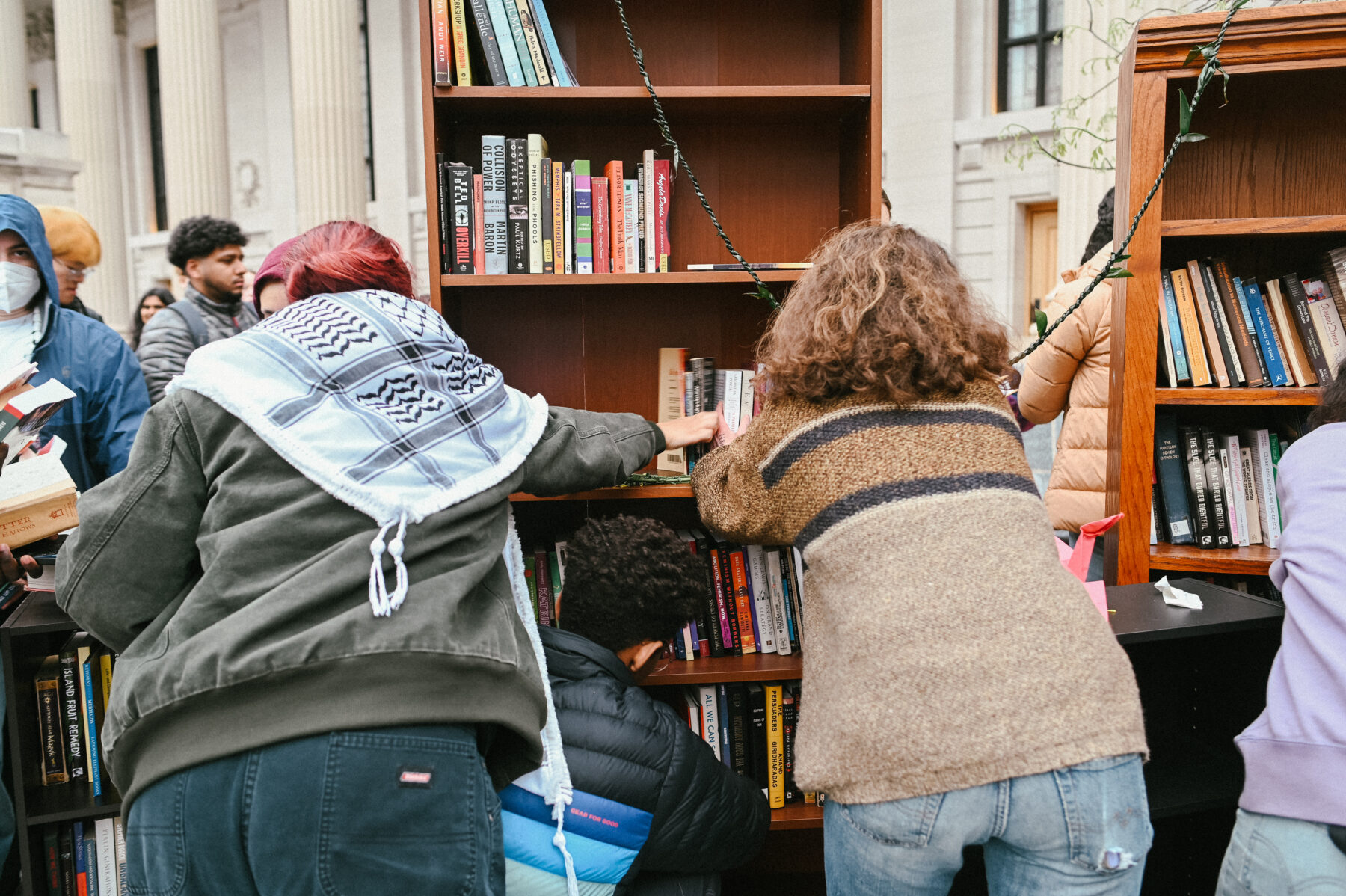
“In retrospect, he was treating us like adults who he can have a conversation with, and that was treating us with a certain level of respect that I feel is less common in the world today,” said Balbale, who is now a professor at New York University. “So many universities, including Yale and NYU, have doubled down on their representation of the protests as violent and dangerous in a way that further undermines that trust.”
V. A Dangerous Precedent
Today, Countryman is a bespectacled faculty member at the University of Michigan, where he is the chair of the African American and African Studies department. As a former student protester and now educator, he believes that arrests only worsen campus environments, universities’ reputations, and students’ overall well-being.
“I could see that there were lessons learned from the experience in the anti-apartheid movement, and the university seemed to be applying those to grapple with students around issues, whether it’s pro-labor protests, or the climate protests, or whatever else,” Countryman said. “So it’s striking that they have abandoned that—they’ve gone back to arrests.”
The act of deploying police to respond to nonviolent student activities sets a dangerous precedent, Greta LaFleur argued.
“I don’t think it is in any way ever safe to bring law enforcement onto college campuses as a means of enforcing college policy ever,” LaFleur said. “And there’s a really clear example of why you shouldn’t do that, and that example is Kent State.”
On May 4, 1970, four students attending a largely peaceful protest against the Vietnam War at Kent State University in Kent, Ohio were shot to death by members of the state’s National Guard. The university had called in the National Guard after a series of rowdy demonstrations around campus earlier in the week. Nine other students were injured, including one person who became paralyzed for life.
The Kent State example represents an extreme, but the potential for any degree of violence when calling in law enforcement cannot be dismissed. At multiple other universities, the police presence at recent pro-Palestine protests has endangered current students, with police beating and pepper spraying protesters and student journalists. At Columbia University, an officer’s gun fired unintentionally during an interaction with student protesters.
According to meeting minutes from a faculty senate meeting held three days after the April 22 arrests on Beinecke Plaza, Dean Lewis told faculty he had lost his control and authority over the situation on Saturday evening, when two counter-protesters entered heated confrontations with protesters after attempting to film them. Police were a necessary response to escalating tension, Lewis said. But some faculty members pointed out that the arrival of police officers themselves to a nonviolent protest caused the escalation and a feeling of inevitable conflict.
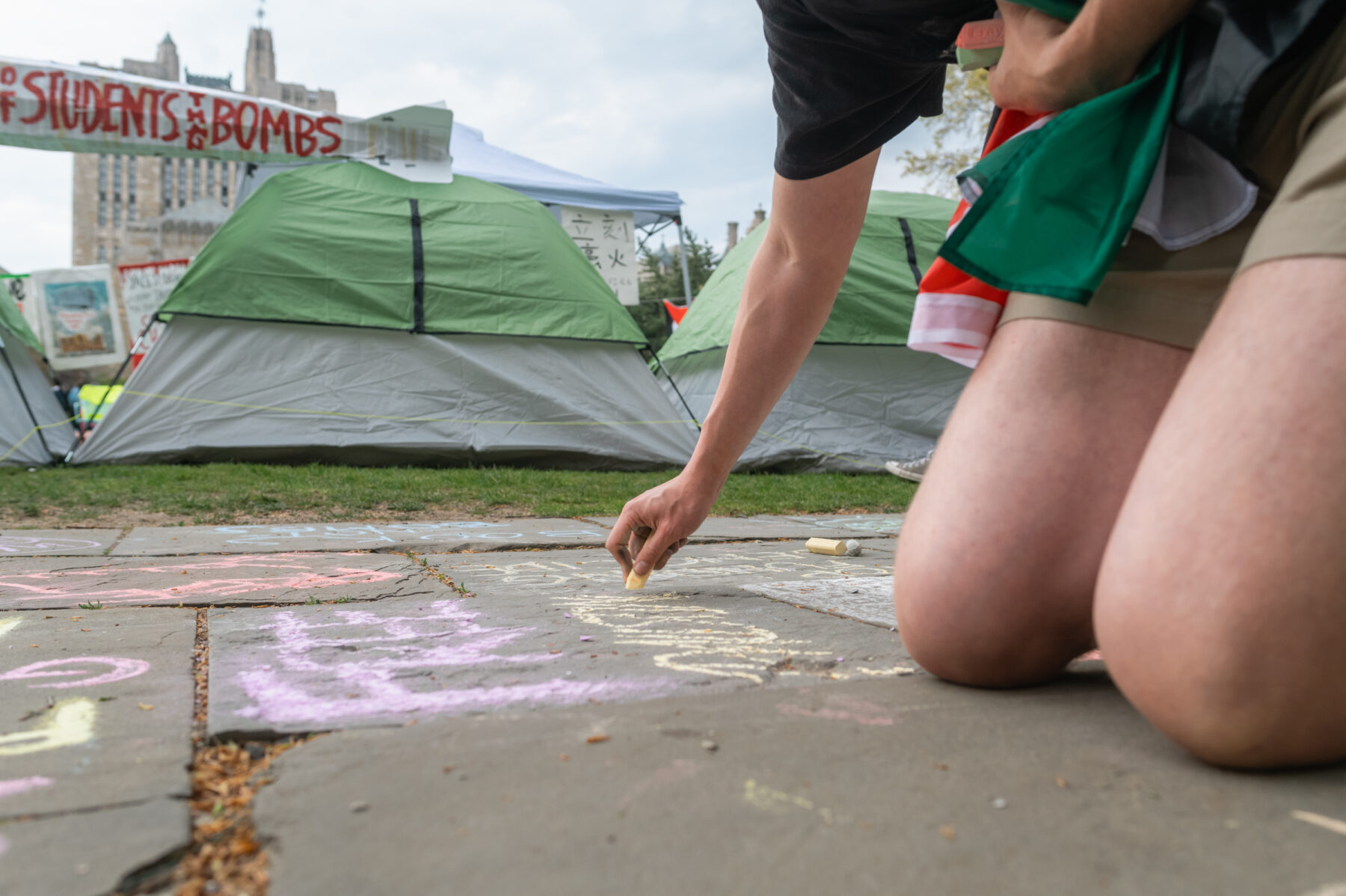
“In fifty years, [Yale] will celebrate us for being activists and standing up for what we believe in… the same ways they celebrate the anti-apartheid movement,” Padilla-Smith told me. “But in the moment, we’re criminalized, excluded from meetings, basically rushed out of the university as fast as we can be.”
Yale has taken steps to address the arrests of the spring, allowing students to meet with one trustee. The university has also changed its guidelines around free expression to restrict outdoor and overnight gatherings, chalk use, and postering. Yale has hired “free expression facilitators,” who a university spokesperson said are responsible for “supporting speaker events, rallies, vigils, gatherings, protests, and counterprotests.” This semester, the free expression facilitators have stood to the side and observed demonstrations and teach-ins on Cross Campus and Beinecke Plaza, some of which Yale agreed to sanction.
Yet many of the students arrested last fall continue to feel cast aside. When the Sumud Coalition was granted a meeting with one trustee in September, the Yale Corporation denied all of the group’s initial terms for meeting—including allowing students who were arrested or facing disciplinary charges to attend—in an email to organizers.
Hutten and Padilla-Smith are still students at Yale, where they continue to be involved with teach-ins, campaigns, and rallies held by the Sumud Coalition. They said that their relationship with the school has changed for the worse.
“For student activists, how are you supposed to attend classes and build relationships with professors, and invest in this university when you also have cops on every corner?” Hutten asked. “And then walking to class, you see the cop who arrested you.”
Outside of activist work and academics, Hutten avoids spending more time on campus than she needs to. Her trust in the university to engage in productive conversation has eroded.
–Megan Vaz is a senior in Pierson College.

